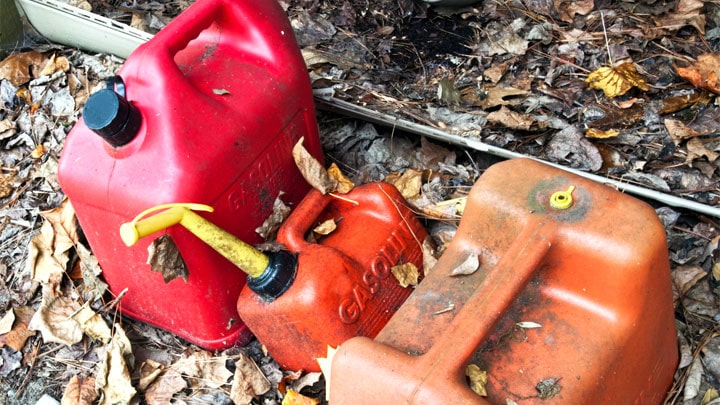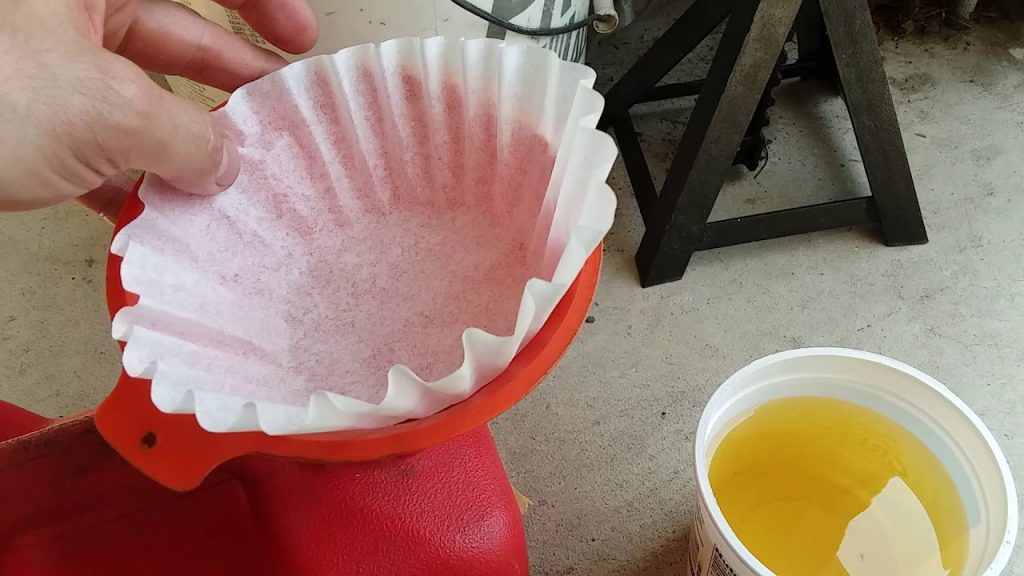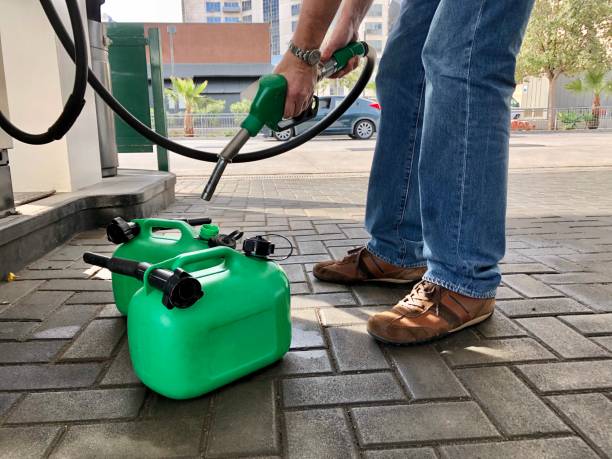In an ideal future, we would all want to run cars on solar energy, but now, this idea is still in the research process. Instead, we depend on perishable fuels like gasoline. Supposedly, you have the gasoline can that sits in your car for a while. As we know, over time, its quality can be broken down and degraded due to external factors.
What to do with old gasoline? Pouring it away may be very wasteful. How about reconditioning the old gasoline and reusing it? Fuel prices are on the rise. Reusing gasoline will be an economical solution for many drivers. But how to rejuvenate old gasoline? Let’s explore and find an effective process for refreshing your fuel.
Contents
How Long Does Gasoline Last?
Does your fuel expire? The answer is “Yes”, your gas can really go bad. However, it doesn’t have an exact number when talking about the gas expiration. We could say it will depend on many elements, such as what kind of fuel you are using and how and where your gasoline is stored. Humidity, heat, and oxygen all have an effect on the condition of the lifespan of fuel.
In fuel-stabilized gasoline, ethanol will lose its flammability within 3-6 months, no matter where it is stored. The fuel stabilizer keeps gasoline, especially gasoline with ethanol (E10, E15), from breaking down in vehicles that are stored for half a year or more. In contrast, non-ethanol gasoline also stays the same condition when stored in the fuel tank as well as in the can for about a month.
What will happen If you use the old gasoline for your car?
Are you worried about old gasoline in your car? It will hurt your car? The good news is that some types of gasoline can last between three and six months in your car that can’t harm the engine. However, it can reduce the overall performance of your car and you may notice side effects such as poorer gas mileage than normal.
When these parts become blocked, the whole car begins to operate poorly. It can slip, have trouble accelerating, lose power, stop idling, or won’t start at first. The final part where old gasoline becomes an issue is inside the cylinders of your engine. Varnish will turn into carbon, so it sticks around the cylinders. This layer increases wear-on and friction in your engine and reduces fuel efficiency.

How to store your gasoline to make it last?
If you have a can of full gasoline, how do you store it properly? If your gasoline is exposed to humidity and high temperatures, it can pose a potential fire hazard and increase volatility. For this reason, a tank containing more than 5 gallons of fuel should not be used.
The right containers are only part of the puzzle: it’s a vital factor to store gasoline and other flammable liquids in safe, well-ventilated areas, and keep away from any source of electricity or heat. A locked building away from everyone with a dry, cool corner is a great location.
>> Read more: Why Does E85 Make More Power Than Gasoline?
Is It Possible To Recondition Old Gasoline?
Your gasoline may be old, very old, but it may not really be as bad as other than saving. Some drivers said you should put a gas stabilizer right after you buy the gasoline. They are all sure that there are no additives that can make old gasoline work again. Can we cure the old gasoline? The answer “Yes” or “No”, will depend on the condition of your gasoline. Yes if your gasoline is still in good condition although it’s a little old. No, if your fuel has gotten out of your control – not necessarily due to age. The cause could be external factors: pollution, a chemical reaction, phasic separation, etc…
When Your Old Gasoline Can’t Be Recovered?
Your effort to save the old gas will be wasteful if you notice the signs that we will share below. If you notice the gasoline appears cloudy or milky, and there are particles floating in the gasoline that you can easily see by visibility, there will be no chance for you to reuse this fuel. When the gas has gone too bad, you will see it has an almost muddy color and a sour odor that is easily distinguishable from typical fuel odors.
Older gasoline will begin a separation phase process. What do you know about this process? The phase separation process happens inside a storage tank when enough water is mixed with gasoline mixed with ethanol. The consequence is that the ethanol molecules attach to the water molecules, resulting in heavy ethanol molecules falling to the bottom of the tank. At this time you will see 2 liquid layers in the tank – an ethanol-water “cocktail” at the bottom and a gasoline layer at the top. No matter what stage your gasoline is in during separation, it can’t be reused.
To be easy to understand If something looks like oil floating on the gasoline or has a grade and color and density difference, your ethanol gas has separated and likely won’t stay.
How To Rejuvenate Old Gasoline- Detail Steps.
As you know, not all old gasoline can be recovered due to the chemical process or external factors. However, there are other factors that affect the decision of whether your gasoline can be rejuvenated or not. Before starting the process of reconditioning the fuel, it will have some factors you should consider:
Factors you need to consider before reconditioning old gasoline:
- Type of your car: If your car is a fuel injection vehicle, reviving gasoline is not a safe method with these models, because old gasoline is more likely to clog the fuel injectors of your engine. Although this fuel has experienced the reviving process, the reconditioned gasoline can’t perform effectively like new fresh gasoline. Moreover, it can be easy to leave a scale in your engine compartment.
- Consider the amount of old gasoline: You can find that this factor may be not related to your decision but actually, it’s quite important. You should compare the cost between the time you will spend recovering and the effects on your engine and the cost you will pay for buying new gasoline.
Step by steps to rejuvenate old gasoline
Let’s move to the most awaited part of our article: How to make old gas usable?

Mixing new gasoline with old fuel
Step 1: You need to prepare the necessary things for this process: an empty barrel or canister with a large enough capacity that can be twice as large to hold the amount of gasoline you will recycle. Don’t forget to buy new or fresh gasoline that corresponds to the amount of gasoline you will recondition.
Step 2: After gathering all materials, you will pour high-octane gasoline into the barrel with old fuel with the idea ratio: 50% old gasoline and 50% fresh gasoline.
Step 3: Gently shake a barrel for 1 minute to mix gasoline and let it stay about 15 minutes. The purpose of this step is that you are adding new combustion elements back to the old gasoline to restore some of the quality of the gasoline.
Step 4: Use the new mixture as new gasoline. Although the resulting mixture has octane content due to being diluted, it is still guaranteed to be used again. It is important that you are extending your fuel and not wasting resources due to old gasoline. You should consider the situation before putting the sketchy mixture into your engine. Is it worth it for you to trade off?
Using octane booster gasoline
When researching products or additives to recondition old gasoline, you may come across octane boosters. A liquid additive, as their name by increasing the octane rating of your vehicle’s fuel. Whether you drive a car, truck or SUV, using an octane booster can provide better performance. But what exactly is an octane booster?
An octane booster is added to a vehicle’s fuel tank or old gasoline to increase its octane rating. In general, high-octane fuel can withstand more detonation in the engine’s combustion chamber than low-octane fuel. An octane booster is simply a product that, when added to a vehicle’s fuel tank, increases the octane rating of the fuel. Most gasoline-powered vehicles today have an idea octane rating of 87 or higher.
What is the most economical way to ensure that your gasoline has the proper octane:
- Pour octane into the fuel tank. The turbocharger enters the tank before adding more fuel. In this step, you must make sure that the turbocharger mixes with your old gasoline, as the overflow can mix with the octane booster.
- Your octane rating is the octane rating of the gasoline you purchased plus the number of octane boosters that increase your level. We can take an example if your old gasoline is 93. After you add the octane booster that increases it by 3, the new gasoline lever will be 96.
FAQs
How long can you store gasoline when using stabil?
STA-BIL additive treatment — including ethanol treatments, fuel stabilizers, and diesel fuel stabilizers — contains special ingredients. This treatment product contains a powerful blend of chemicals and additives that neutralize acids, prevent gasoline from oxidizing, and coat metal surfaces to prevent corrosive deterioration. For many decades, this additive product is proven to save millions of gallons of fuel from deterioration. Depending on the product you use, a fuel stabilizer can help you last the lifespan of your gasoline from one to three years.
How to tell if gasoline is bad?
Knowing the condition of your gasoline can help you get the right decision: whether you should recondition or dispose of it? When you notice the gasoline is going bad (beyond repair), you shouldn’t use it to fill any engine because it can make your engine seriously damaged. Starting your car can tell if gasoline is bad or not. If your car is idling continuously, stops frequently during acceleration, or won’t start, your gas has failed. Sometimes, bad gas will also make the check engine light come on.
Don’t forget to take a look at the color of the gasoline. What color should your gasoline be? Gasoline will usually be slightly clear or slightly yellow. The color of gasoline will depend on the octane rating of the gasoline. If gasoline is darker than usual or has a sour smell, it’s probably spoiled and it’s time to find the best method for your fuel.
>> Related posts: What Color Is Gasoline: Here is The Real Answer!
How to dispose of old gasoline?
Old gasoline can be really a big problem in your car or other vehicles. But many drivers have no idea what they should do with this old fuel. Gasoline is so pervasive in our daily lives that it’s easy to forget how dangerous a compound it can be. Putting gasoline into the environment can have a serious effect on public health and wildlife. It’s very important for drivers to know how to dispose of old gasoline safely and legally.
Depending on your country, there will be different laws regarding the disposal of gasoline. If you are caught illegally pouring gas, you will face some fines. Moreover, for some towns, doing this may even be considered a crime.
Let’s refer to some simple following steps:
- Put old gasoline in a container that is approved by the government.
- Look for a local disposal site by having information from a town or waste management agency.
- Find an approved disposal site to dispose of your old gasoline
How to keep gasoline fresh in the car?
There are some simple ways to prevent your gasoline from going bad:
- You should start the car regularly even for short distances or several times a week. This will help prevent fuel from stagnation in your reservoir and make you pump fresh gasoline at a certain time.
- Another way to keep your gasoline from degrading over time is to refill the tank as you fill it up. This will create less moisture in the tank, which can cause room for water contamination and eventually corrosion. In addition, a full tank will limit the amount of oxygen in the tank that the gasoline can quickly evaporate into.
- You can add suitable additive products to keep the quality of your gas in good condition. However, using additive products is not always good for your car, make sure you take the advice from the mechanic or manufacturers before adding these products.
- And lastly, if you have unused gas, you can store gasoline in a can. But remember to keep your gasoline in a low-humidity or low-oxygen environment.
Final Thoughts: How To Rejuvenate Old Gasoline?
As long as old gasoline is not contaminated by any substances or is beyond repair, you can choose to recondition your gasoline. It can help you save an amount of money. But before deciding to do this process, keep in mind that the safety of you and your car is always first.



